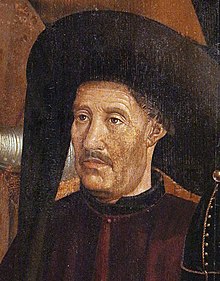Sagres school

The School of Sagres (Escola de Sagres in Portuguese), also called Court of Sagres is supposed to have been a group of figures associated with fifteenth century Portuguese navigation, gathered by prince Henry of Portugal in Sagres near Cape St. Vincent, the southwestern end of the Iberian Peninsula, in the Algarve.
Since the nearby port of
The first written mention of a "school" at Sagres in English dates from the seventeenth century by
Scholarly debate

Romantic view
In 1894, C. R. Beazly published a biography of Prince Henry stating that he had installed his court in Sagres in 1418, shortly after the capture of
Critical view

Ever since then, others have nuanced that, rather than a nautical school in the modern sense of the word, Sagres was a meeting place for sailors and scientists to exchange information and techniques regarding maps, shipbuilding and organize expeditions. According to a more critical view, the Portuguese learned navigation in a practical way, on the decks of the ships, and lacking archaeological and documentary support for the supposed "school", consider it a myth of Portuguese history.[6][1][2][3][4]
Majorcan influence
The
"Muitos beneficios tem feytos o virtuoso Infante Dom Anrique a estes Reynos de Portugal, por que descubrió a ilha da Madeyra no anno de nosso senhor de mil CCCCXX, e ha mandau pouoar e mandou a Cicilia pellas canas de açuquar, ...; isso mesmo mandou á ilha de Malhorca por um mestre Jacome, mestre de cartas de marear, na qual ilha primeiramente se fezeram as ditas cartas, e com muitas dadiuas e mercés ho ouue nestes Reynos, ho qual as ensinou a fazer áquelles de que os que em nosso tempo viuem, aprendéram..."[7]
The 16th century Portuguese chronicler João de Barros on his part states:
"..mándou vir da ilha de Mallorca um mestre Jacome, homem mui douto na arte de navegar, que fasia e instrumentos náuticos e que Ihe custou muito pelo trazer a este reino para ensinar sua sciencia aos officiaes portuguezes d'aquella mester"[8]
Though some wonder if the mestre Jacome mentioned in Portuguese sources corresponded to the same mestre Jacome from Maiorca, no other person from that era is known to have bore the same name.
First results
See also
- Angelino Dulcert
- Catalan chart
- Majorcan cartographic school
- Memorias históricas (Capmany)
- Història de la Marina Catalana
- Abraham Cresques
- Arte de navegar
References
- ^ a b Randles (1993). The Alleged nautical school founded in the fifteenth century by Prince Henry at Sagres of Portugal, called the 'Navigator'. Vol. 45. Imago Mundi. pp. 20–28.
- ^ ISBN 978-972-699-273-8.
- ^ a b Rocha, Daniel (8 February 2009). Brazil: nega historian existência da Escola Sagres. Público. Retrieved 16 October 2013.
- ^ a b Marques, Alfredo Pinheiro (2005). Os Descobrimentos e o 'Miller Atlas' (in Portuguese). University of Coimbra. p. 160.
- ^ Beazley, C. R. (1894). Prince Henry the Navigator: The Hero of Portugal and of Modern Discovery, 1394-1460 AD With an Account of Geographical Progress THROUGHOUT the Middle Ages as the Preparation for His Work. Putnam. pp. 160–162.
- ^ Marques, Alfredo Pinheiro (2005). Os Descobrimentos e o 'Miller Atlas' (in Portuguese). University of Coimbra. pp. 52–53.
- ^ Estudos de História, Volume III. UC Biblioteca Geral 1. pp. 10–. GGKEY:7186FCQBHS5.
- ^ Bibliografia Henriquina, Vol. I. UC Biblioteca Geral 1. pp. 2–. GGKEY:PGJ4UJDUYAZ.
External links
- Cerqueiro, Daniel (1999). El navegante y la fuerza de las ideas (in Spanish). ISBN 987-9239-09-1.
- "Brasil: historiador nega existência da Escola de Sagres". PÚBLICO (in Portuguese). 2009-02-08.
- "Portolan charts from S.XIII to S.XVI - Additions, Corrections, Updates".
